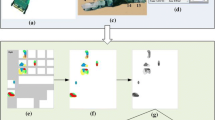Abstract
Lots of tactile sequences can be obtained by using a dexterous hand for grasping different objects. The ability of robotic environmental perception and dexterous manipulation will be significantly improved after these tactile sequences are correctly classified. Therefore, tactile sequences are separated into series of subgroups, and a method based on linear dynamical system (LDS) is used to extract features. Since these LDSs lie in non-Euclidean space, the Martin distance, which is a measurement different from Euclidean distance, is applied to calculate the distance between two LDSs, and the K-Medoid algorithm is used for clustering. The codebook is obtained after clustering and is used to represent time sequences to get a Bag-of-System (BoS). Then the BoS and labels are sent to Extreme Learning Machine (ELM) to train a classifier. Finally, three databases, KTH-7, KTH-10 and TSH-8 are used to evaluate our algorithm.
概要
创新点
触觉序列中包含了丰富的物理信息, 对这些信息进行分析可以实现物体分类, 实现机器人灵巧抓取. 使用线性动态系统(Linear Dynamic System, LDS)对触觉信息进行建模, 由于LDS存在于非欧式空间中, 因此使用能够充分刻画LDS特性的Martin距离作为距离的衡量标准. 在使用K-Medoid算法进行聚类后, 采用了机器学习中流行的Bag-of-Words框架对触觉信息进行分析, 并使用极限学习机进行物体分类. 在实验验证部分, 对3种触觉传感器所构建的触觉序列进行了算法测评.
Similar content being viewed by others
References
Chen X W, Jin X, Wang K. Lighting virtual objects in a single image via coarse scene understanding. Sci China Inf Sci, 2014, 57: 092105
Chen Q, Zheng E L, Liu Y C. Pose estimation based on human detection and segmentation. Sci China Ser-F: Inf Sci, 2009, 52: 244–251
Huang T J, Tian Y H, Li J, et al. Salient region detection and segmentation for general object recognition and image understanding. Sci China Inf Sci, 2011, 54: 2461–2470
Zhuo Z H, Zhai W M, Li X, et al. Local adaptive segmentation algorithm for 3-D medical image based on robust feature statistics. Sci China Inf Sci, 2014, 57: 102313
Liu H, Greco J, Song X, et al. Tactile image based contact shape recognition using neural network. In: Proceedings of IEEE Conference on Multisensor Fusion and Integration for Intelligent Systems, Hamburg, 2012. 138–143
Zhang J, Song C, Hu Y, et al. Improving robustness of robotic grasping by fusing multi-sensor. In: Proceedings of IEEE Conference on Multisensor Fusion and Integration for Intelligent Systems, Hamburg, 2012. 126–131
Russell R A, Wijaya J A. Object location and recognition using whisker sensors. In: Proceedings of Australasian Conference on Robotics and Automation, Brisbane, 2003. 761–768
Goldfeder C, Ciocarlie M, Dang H, et al. The Columbia grasp database. In: Proceedings of International Conference on Robotics and Automation, Kobe, 2009. 1710–1716
Bekiroglu Y, Laaksonen J, Jorgensen J A, et al. Assessing grasp stability based on learning and haptic data. IEEE Trans Robot, 2011, 27: 616–629
Bekiroglu Y, Kragic D, Kyrki V. Learning grasp stability based on tactile data and HMMs. In: Proceedings of IEEE RO-MAN, Viareggio, 2010. 132–137
Drimus A, Kootstra G, Bilberg A, et al. Design of a flexible tactile sensor for classification of rigid and deformable objects. Robot Auton Syst, 2014, 62: 3–15
Soh H, Su Y, Demiris Y. Online spatio-temporal gaussian process experts with application to tactile classification. In: Proceedings of IEEE/RSJ International Conference on Intelligent Robots and Systems, Vilamoura, 2012. 4489–4496
Jimenez A R, Soembagijo A S, Reynaerts D, et al. Featureless classification of tactile contacts in a gripper using neural networks. Sensor Actuator A-Phys, 1997, 62: 488–491
Schneider A, Sturm J, Stachniss C, et al. Object identification with tactile sensors using bag-of-features. In: Proceedings of IEEE/RSJ International Conference on Intelligent Robots and Systems, St Louis, 2009. 243–248
Schopfer M, Pardowitz M, Haschke R, et al. Identifying relevant tactile features for object identification. Spring Tract Adv Robot, 2012, 76: 417–430
Xiao W, Sun F, Liu H P, et al. Dexterous robotic hand grasp modeling using piecewise linear dynamic model. In: Proceeding of IEEE Conference on Multisensor Fusion and Integration for Intelligent Systems, Hamburg, 2012. 52–57
Ravichandran A, Chaudhry R. Categorizing dynamic textures using a bag of dynamical systems. IEEE Trans Patt Anal Mach Intell, 2013, 35: 342–353
Baydogan M, Runger G, Tuv E. A bag-of-features framework to classify time series. IEEE Trans Patt Anal Mach Intell, 2013, 35: 2796–2802
Liu H, Xiao W, Zhao H, et al. Learning and understanding system stability using illustrative dynamic texture examples. IEEE Trans Educ, 2014, 57: 4–11
Doretto G, Chiuso A, Wu Y N, et al. Dynamic textures. Int J Comput Vis, 2003, 51: 91–109
Cock D K, Moor B D. Subspace angles between ARMA models. Syst Control Lett, 2002, 46: 265–270
Huang G B, Zhou H, Ding X, et al. Extreme learning machine for regression and multiclass classification. IEEE Trans Syst Man Cybern Part B-Cybern, 2012, 42: 513–529
Huang G B, Zhu Q Y, Siew C K. Extreme learning machine: theory and applications. Neurocomputing, 2006, 70: 489–501
Chitta S, Stuprm J, Piccoli M, et al. Tactile sensing for mobile manipulation. IEEE Trans Robot, 2011, 27: 558–568
Author information
Authors and Affiliations
Corresponding author
Rights and permissions
About this article
Cite this article
Ma, R., Liu, H., Sun, F. et al. Linear dynamic system method for tactile object classification. Sci. China Inf. Sci. 57, 1–11 (2014). https://doi.org/10.1007/s11432-014-5212-7
Received:
Accepted:
Published:
Issue Date:
DOI: https://doi.org/10.1007/s11432-014-5212-7




